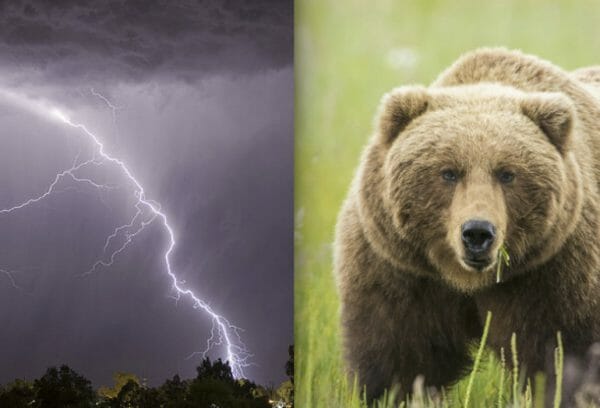
U.S.A. –-(Ammoland.com)- In a March 15, 2020 article about a bear encounter by Caroline Wellbery, a bear biologist makes a hyperbolic claim. It is not unusual for people to make hyperbolic claims about bears, which are not founded in facts or data. It is irresponsible for experts in the field to do so. From the washingtonpost.com:
There is a bigger chance of getting hit twice by lightning, Craighead says, than being mauled by a bear.
As with any statistical assessment, it depends on a number of assumptions. If you are talking about the United States as a whole, Craighead’s claim is false.
Over the last decade, the number of people killed by lightning per year, according to weather.gov, has been 26. The number of people struck by lightning is about 10 times that number, or about 260 a year, or about 1 out of 1.27 million in a year. The number struck by lightning has been falling. The expected lifespan in the United States is about 79 years.
Assuming that each person has half of their life to live after the first strike, at any one time, there are about 79/2 x 260 people who have been struck by lightning once, or 10,270 living in the United States. Each of those, in a given year, has a chance of being struck by lightning again. Because the odds are so small, they are, essentially, additive, so, for a given year, they are very close to 10,270/1.27 million, or .008 per year, or about 1 person every 123 years.
There are a couple of people in existence who have been struck by lightning more than once, so the odds may be a little greater. Then again, the number of people struck by lightning has been falling, while the number of people mauled by bears has been rising.
There are many times as many people alive who have been mauled by a bear, as have been struck by lightning twice.
According to research in Alaska, there are about seven bear attacks requiring at least one day in the hospital for each fatal bear attack. There are other people who only need stitches and are released, or who have other, minor injuries.
There have been 18 fatal bear attacks in the United States in the last decade.
7 x 18 is 126, or about 12 bear maulings requiring at least 1 day in the hospital each year, on average. That does not count the people attacked by a bear who can be released from the hospital the same day. Over the same time period, the number of people being hit, twice, by lightning would be .008 x 10 or about .08 people per decade.
In the United States, your chance of getting mauled by a bear is about 1500 times as great as being struck by lightning, twice.
Craighead is not just wrong in his estimate, he is off by three orders of magnitude.
The comparison of lightning strikes to bear attacks is a frivolous, Orwellian exercise. All risks should be taken in context. In some contexts, bear attacks are a serious risk. In most, they are not. In the backwoods of Yellowstone park, the chance of being in an automobile accident are very small, but the chance of being killed by a bear is significant, about the same at that of being in a fatal automobile accident in the rest of the United States.
Where most bear attacks occur, deaths by bear can be more frequent than deaths by lightning strike. They are clearly more common than being hit twice by lightning. Seven of the eighteen fatal bear attacks in the United States in the last decade occurred in Alaska. There were no recorded deaths by lightning in Alaska during that decade.
Humans are, generally, far more dangerous to other humans than are bears. Bears may kill, over the entire world, a dozen humans or less in a year (there are more bear attacks in Asia than in North America, and almost as many in Europe). Humans kill about half a million humans in a year.
In the backcountry of Yellowstone park, bears kill more humans than humans do.
Humans learn from others and learn how to prevent attacks and exposure to lightning strikes. A person who has been struck by lightning may be careful to expose themselves less.
Long experience with bears has resulted in people knowing how to effectively avoid and/or stop a bear attack. It is likely about 10 bears are killed for each bear that attacks and injures a human. The chance of a bear mauling is not the same as the chance of a bear attack. Bear attacks occur much more frequently. They mostly fail, and the bear is killed or driven off.
In my research, handguns are shown to be about 97% effective in stopping bear attacks.
About Dean Weingarten:
Dean Weingarten has been a peace officer, a military officer, was on the University of Wisconsin Pistol Team for four years, and was first certified to teach firearms safety in 1973. He taught the Arizona concealed carry course for fifteen years until the goal of Constitutional Carry was attained. He has degrees in meteorology and mining engineering, and retired from the Department of Defense after a 30 year career in Army Research, Development, Testing, and Evaluation.
